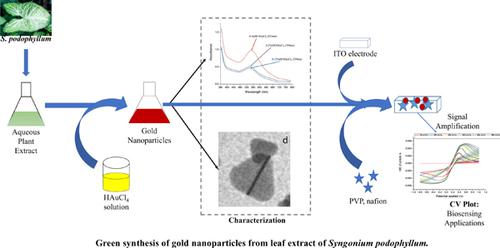Current Nanoscience ( IF 1.4 ) Pub Date : 2020-12-31 , DOI: 10.2174/1573413716999200507125437 Saumya Srivastava 1 , Anjana Pandey 1

|
Background: The existing methods of analyte detection by various biochemical processes have certain drawbacks including nonlinearity and detection limits. The nanotechnology has paved a way for the development of new devices i.e., nano-biosensors, by amalgamation of nanoparticles with recognition elements. These nano-biosensors have the capabilities to overcome the drawbacks of conventional methods.
Objectives: Present study was planned to analyze the biosensing potential of indium tin oxide (ITO) electrode modified with gold nanoparticles synthesized using aqueous extract of S. podophyllum.
Methods: In present study, first time rapid green synthesis of gold nanoparticles from leaf extract of Syngonium podophyllum is reported. The synthesized nanoparticles were then characterized physically by UV-Visible spectroscopy, particle size analysis, fluorescent spectroscopy, Fourier transform infrared spectroscopy and transmission electron microscopy (TEM), and HR (High resolution)-TEM.
Results: The particles were observed to be in average size range of 30-70 nm. Furthermore, the ITO electrode was modified with the prepared nanoparticles and analyzed by ellipsometry. The electrochemical characteristics of the modified electrodes were analyzed by cyclic voltammetry.
Conclusion: The results exhibited a higher current gain, thus signifying a higher signal amplification at the electrodes and paves the way for their use in electrochemical nanobiosensors.
中文翻译:

刺五加叶提取物介导的生物传感潜力的金纳米颗粒的合成和表征:一种可持续的方法。
背景:现有的通过各种生化过程进行分析物检测的方法具有某些缺点,包括非线性和检测极限。纳米技术通过将纳米粒子与识别元素融合在一起,为开发新设备(即纳米生物传感器)铺平了道路。这些纳米生物传感器具有克服常规方法的缺点的能力。
目的:目前的研究计划旨在分析用鬼臼链球菌水提取物合成的金纳米粒子修饰的铟锡氧化物(ITO)电极的生物传感潜力。
方法:本研究报道了首次从鬼臼叶提取物中快速绿色合成金纳米颗粒。然后通过紫外-可见光谱,粒度分析,荧光光谱,傅立叶变换红外光谱和透射电子显微镜(TEM)和HR(高分辨率)-TEM对合成的纳米粒子进行物理表征。
结果:观察到颗粒的平均尺寸范围为30-70nm。此外,用制备的纳米粒子对ITO电极进行修饰,并通过椭圆偏振光度法进行分析。通过循环伏安法分析了修饰电极的电化学特性。
结论:结果显示出更高的电流增益,从而表明电极上的信号放大更高,并为它们在电化学纳米生物传感器中的使用铺平了道路。











































 京公网安备 11010802027423号
京公网安备 11010802027423号